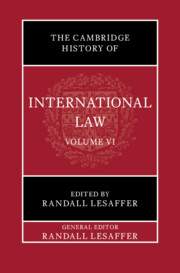Book contents
- The Cambridge History of International Law
- The Cambridge History of International Law
- Frontispiece
- The Cambridge History of International Law
- Copyright page
- Contents
- Plates
- Contributors
- Preface
- Abbreviations
- Part I International Law in Renaissance Europe (1492–1660)
- 1 The Law of Nations in Renaissance Europe
- 2 Territory and Jurisdiction in Renaissance Europe
- 3 Beyond the Free Sea
- 4 War and the Use of Force in Renaissance Europe
- 5 Warfare on Land in Renaissance Europe
- 6 The Law of Maritime Warfare during the Transition between Medieval and Early Modern Europe
- 7 Peacemaking in Renaissance Europe
- 8 Trade and Navigation in Renaissance Europe
- 9 Diplomacy in Renaissance Europe
- 10 Dispute Settlement in Renaissance Europe
- 11 The Ottoman Encounter and the Law of Nations in the Renaissance
- Part II International Law in Old Regime Europe (1660–1775)
- Index
- Plate Section (PDF Only)
- References
8 - Trade and Navigation in Renaissance Europe
from Part I - International Law in Renaissance Europe (1492–1660)
Published online by Cambridge University Press: 22 April 2025
- The Cambridge History of International Law
- The Cambridge History of International Law
- Frontispiece
- The Cambridge History of International Law
- Copyright page
- Contents
- Plates
- Contributors
- Preface
- Abbreviations
- Part I International Law in Renaissance Europe (1492–1660)
- 1 The Law of Nations in Renaissance Europe
- 2 Territory and Jurisdiction in Renaissance Europe
- 3 Beyond the Free Sea
- 4 War and the Use of Force in Renaissance Europe
- 5 Warfare on Land in Renaissance Europe
- 6 The Law of Maritime Warfare during the Transition between Medieval and Early Modern Europe
- 7 Peacemaking in Renaissance Europe
- 8 Trade and Navigation in Renaissance Europe
- 9 Diplomacy in Renaissance Europe
- 10 Dispute Settlement in Renaissance Europe
- 11 The Ottoman Encounter and the Law of Nations in the Renaissance
- Part II International Law in Old Regime Europe (1660–1775)
- Index
- Plate Section (PDF Only)
- References
Summary
In the period of the Renaissance, trade became a matter of legislation and policy. Municipal governments and princes aimed to facilitate trade. International trade relations became increasingly supervised by states. This came in tandem with more treaties. From the middle of the fifteenth century onwards, specialized institutions were created and they increased control over foreign merchants. As a result of growing government intervention, the rules relating to trade were found in bylaws, charters and statutes. Besides those there were customs of trade, which were mostly local. New mercantile techniques, becoming widespread in this period, were maritime insurance, bills of exchange and partnerships of merchants. Insolvency became regulated in the sixteenth century. From the 1500s onwards, rights of hospitality for traders and a right of trade were developed in ius gentium writings. However, due to the mostly local customs and legislation, trade across European countries was far from harmonised. Gerald Malynes proposed a universal custom of trade, but he struggled with the combination of ius gentium ideas with the more factual customs of trade. His views nonetheless laid the basis for later categorisations of commercial law as being customary and transnational.
- Type
- Chapter
- Information
- The Cambridge History of International Law , pp. 263 - 300Publisher: Cambridge University PressPrint publication year: 2025

